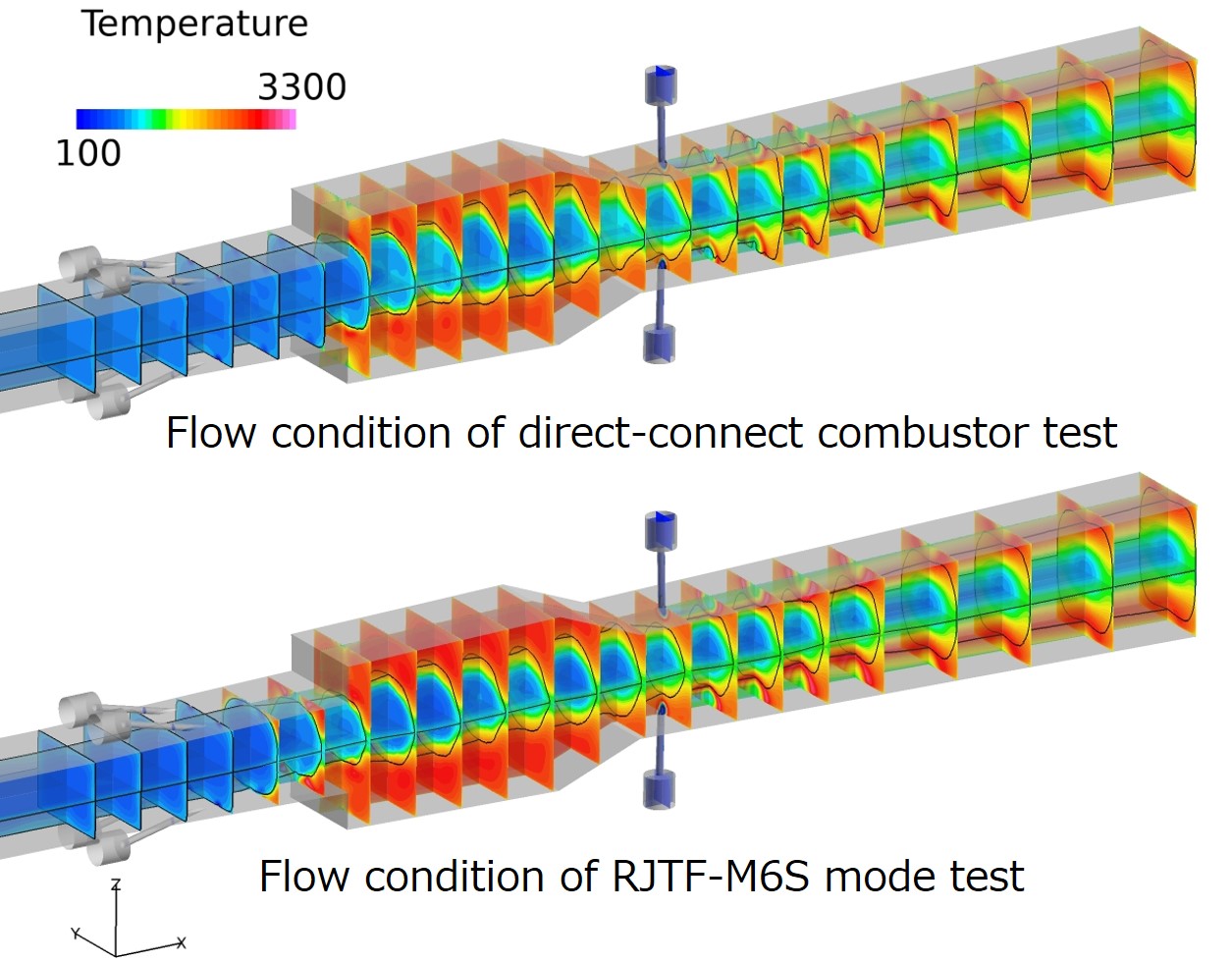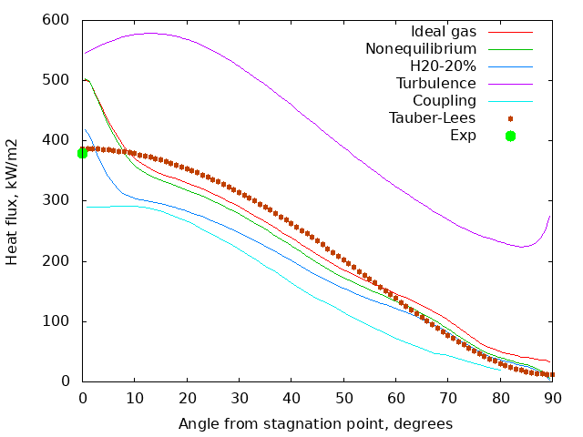Fundamental Researches of Fluid and Combustion for the Hypersonic Flight
JAXA Supercomputer System Annual Report April 2020-March 2021
Report Number: R20ECMP18
Subject Category: Competitive Funding
- Responsible Representative: Kouichi Okita, Director, Research Unit IV, Research and Development Directorate
- Contact Information: Masahiro Takahashi(takahashi.masahiro@jaxa.jp)
- Members: Masahiro Takahashi, Masatoshi Kodera, Toshihiko Munakata, Masaaki Fukui, Masaharu Takahashi, Susumu Hasegawa, Sadatake Tomioka, Shun Takahashi, Taku Inoue, Kan Kobayashi, Gouji Yamada, Yusuke Mizuno, Rirai Yamashita
Abstract
The wind tunnel tests by using sub-scaled models play important roles for the development of the air-breathing propulsion system for a hypersonic transporter. However, in some cases, the flow of the wind tunnel is ''vitiated'' due to the heating process and/or the complex flow-path of the facility. To rise the total temperature to produce the high-speed flow, a combustion heating is usually applied, introducing the water vaper to the air stream. The complex flow-path of the facility would increase turbulence. Both the phenomena might affect the supersonic combustion process. To clarify the effects of the flow vitiation and ultimately, to establish the adjustment methodology that can deduce the data of real flight from the wind tunnel data, JAXA has initiated the 5-years study. The final goal is conducting the flight experiment to obtain the data on the supersonic combustion in an actual flight condition and verify the methodology by using both the flight data and the corresponding wind tunnel data.
Reference URL
N/A
Reasons and benefits of using JAXA Supercomputer System
Recently, hydrocarbon fuels become more promising fuels for a supersonic combustor than hydrogen because of those high thrust density. A gaseous ethylene is selected as the fuel for the present flight experiment. Ethylene is rather simple hydrocarbon, but much more chemical species contributes to the combustion process than hydrogen. In addition, the flow conditions in the supersonic combustor and those around the hypersonic flight test vehicle are quire severe. As a result, the CFD for the present design evaluation requires large computation time. Furthermore, many cases of the CFD must be executed for aerodynamic design of the flight test vehicle and the combustor model within the scheduled period. Therefore, the use of the JAXA Supercomputer System is essential for the success of the present research program.
Achievements of the Year
(1) Development of a tool for predicting facility dependence on supersonic combustion:
Three-dimensional CFD analysis was carried out for a hydrogen fueled scramjet engine tested at the Ramjet Engine Test Facility (RJTF) under Mach 6 flight conditions. As a result, for a fuel equivalence ratio of 0.3, various combustion modes were observed depending on the combustor wall temperature, operation of igniter, presence of water vapor in air conditions as well as initial solutions. Those combustion modes were classified into 4 groups: Partially-anchored, Fully-anchored, Partially-blow-off and Blow-off modes, from the point of view of flame anchor point, and were investigated in detail. In addition, it was demonstrated that several combustion phenomena occurred in the RJTF tests corresponded to one of them.
(2) Combustion flow CFD of a supersonic combustor for JAXA flight experiment:
Combustion test of an ethylene-fueled supersonic combustor model for JAXA flight experiment has been conducted by using RJTF with its vitiation air heater at the test flow condition corresponding to Flight Mach number of 6. Now, we have the combustion test results of the three flow conditions, those are the direct-connected combustor tests, RJTF test results with both the storage air heater mode and the vitiation air heater mode. Three-dimensional RANS CFD was carried out for these three test flow conditions to examine its accuracy. For JAXA flight experiment, influence of angle-of-attack and side-slip angle of the flying test bed as well as the dynamic pressure of the incoming flow on the combustion characteristics were also investigated by CFD.
(3) Evaluation of aerodynamic characteristics for JAXA flight experimental vehicle:
For JAXA's flight experiment on supersonic combustion, we are building up the aerodynamic characteristics database by CFD. In the present year, we examined accuracy of CFD by comparing with the wind tunnel data using a 1/8-scaled model of the flying testbed (FTB) at Mach 7 turbulent condition. The comparison between the Schlieren photograph from the wind tunnel tests and the Mach number contours by CFD showed that CFD predicted the flow structure around the FTB well. The aerodynamic characteristics of the FTB predicted by CFD agreed well with the experimental ones. Therefore, we concluded that the present CFD can be applied for prediction of the FTB aerodynamic characteristics. The present CFD was currently applied to solve some technical issues relating to the aerothermodynamic characteristics in the detailed design process of the FTB.
(4) Development of a tool for predicting facility dependence on aerodynamic heating:
Development of a tool for predicting facility dependence on aerodynamic heating CFD analysis with facility dependence been treated as parameters was performed to investigate the influence of it on aerodynamic heating. Thermochemical nonequilibrium, inclusion of combustion gas (water vapor), turbulence, and coupled flow-thermal analysis were considered as facility dependence in this numerical analysis. The heat flux distribution around a cylinder at Mach 6.7 was obtained from the simulation, showing that the heat flux is highly dependent on facility dependence. Comparison between calculation and experiment was made to validate the caclculated result.
Fig.1: Hydrogen-fueled E1 scramjet engine: Time variation of distributions of OH mass fraction on iso-surface at equivalence ratio of unity assuming before combustion (Partially-blow-off mode)

Fig.2: Ethylene-fueld supersonic combustor for flight test: Comparison of static temperature profiles, top figure: direct-connect combustor test condition, bottom figure: RJTF-M6S mode combustion test condition, total equivalence ratio of ethylene fuel is 0.44.

Fig.3: Comparison of flow-field around the 1/8-scaled test model of JAXA flying-testbed at Mach 7 turbulent condition; Left – the Schlieren photograph taken in the wind tunnel test. Right – the Mach number contours predicted by CFD.
Publications
- Peer-reviewed papers
1) Takahashi, M., Tomioka, S., Kodera, M., Kobayashi, K., Hasegawa, S., Shimizu, T., Aono, J., and Munakata, T., "Numerical Study on Combustor Flow-Path Design for a Scramjet Flight Experiment,'' Transactions of JSASS, Aerospace Technology Japan, ISTS Selected Papers, 2021 (to be publised in July issue).
- Non peer-reviewed papers
1) Kodera, M., Tomioka, S., Munakata, T. and Mitani, T., "Various Combustion Modes in a Scramjet Engine Simulated by CFD," Proceedings of Fluid Dynamics Conference / Aerospace Numerical Simulation Symposium 2020 Online, JSASS-2020-2068-A, 2020.
2) Kodera, M., Tomioka, S., Munakata, T. and Mitani, T., "Various Combustion Modes in a Scramjet Engine Simulated by CFD," Proceedings of Fluid Dynamics Conference / Aerospace Numerical Simulation Symposium 2020 Online, JAXA-SP-20-008, 2021, pp. 69-78.
3) Takahashi, M., Kobayashi, K. and Tomioka, S., "Combustion Test Results of a Supersonic Combustor Model for a JAXA Flight Experiment," Proceedings of Space Transportation Symposium FY2019, (2020-01), Report No. STCP-2019-047, 2020.
4) Mizuno Y., Takahashi, S., Yamada, G., "Investigation of Hypersonic Flow around a Half Circular Cylinder using Coupled Flow-thermal Analysis, AIAA2021-0246, 2021.
- Oral Presentations
1) Kodera, M., Tomioka, S., Munakata, T., and Mitani, T., "Various Combustion Modes in a Scramjet Engine Simulated by CFD," Fluid Dynamics Conference / Aerospace Numerical Simulation Symposium 2020 Online, 2020.
2) Takahashi, M., Kobayashi, K., and Tomioka, S., "Ground Test Evaluation of a Supersonic Combustor for a Flight Experiment," 10th Asian Joint Conference on
Propulsion and Power AJCPP2021, Virtual Conference, 2021.
3) Hasegawa, S. and Tani, K., ''NumericalStudy of JAXA's Experimental Vehicle for Hypersonic Flight,'' IAC 2020, Cyberspace Edition, 2020.
4) Mizuno Y., Takahashi, S. and Yamada, G., "Investigation of Hypersonic Flow around a Half Circular Cylinder using Coupled Flow-thermal Analysis, AIAA Scitech Forum and Exposition, 2021.
- Other
1) Yamada, G., Takahashi, S., "High accurate prediction of aerodynamic heating of hypersonic vehicles," Research Symposium at Tokai University Research Instirute of Science and Technology, 2021.
Usage of JSS
Computational Information
- Process Parallelization Methods: MPI
- Thread Parallelization Methods: N/A
- Number of Processes: 48 - 2880
- Elapsed Time per Case: 400 Hour(s)
Resources Used(JSS2)
Fraction of Usage in Total Resources*1(%): 3.86
Details
Please refer to System Configuration of JSS2 for the system configuration and major specifications of JSS2.
| System Name | Amount of Core Time(core x hours) | Fraction of Usage*2(%) |
|---|---|---|
| SORA-MA | 22,888,486.35 | 4.33 |
| SORA-PP | 65,608.61 | 0.51 |
| SORA-LM | 1.20 | 0.00 |
| SORA-TPP | 0.00 | 0.00 |
| File System Name | Storage Assigned(GiB) | Fraction of Usage*2(%) |
|---|---|---|
| /home | 216.70 | 0.20 |
| /data | 12,655.60 | 0.24 |
| /ltmp | 9,954.74 | 0.85 |
| Archiver Name | Storage Used(TiB) | Fraction of Usage*2(%) |
|---|---|---|
| J-SPACE | 9.47 | 0.31 |
*1: Fraction of Usage in Total Resources: Weighted average of three resource types (Computing, File System, and Archiver).
*2: Fraction of Usage:Percentage of usage relative to each resource used in one year.
Resources Used(JSS3)
Fraction of Usage in Total Resources*1(%): 1.92
Details
Please refer to System Configuration of JSS3 for the system configuration and major specifications of JSS3.
| System Name | Amount of Core Time(core x hours) | Fraction of Usage*2(%) |
|---|---|---|
| TOKI-SORA | 10,316,104.52 | 2.22 |
| TOKI-RURI | 36,133.72 | 0.21 |
| TOKI-TRURI | 32.43 | 0.00 |
| File System Name | Storage Assigned(GiB) | Fraction of Usage*2(%) |
|---|---|---|
| /home | 307.95 | 0.21 |
| /data | 21,833.66 | 0.37 |
| /ssd | 670.39 | 0.35 |
| Archiver Name | Storage Used(TiB) | Fraction of Usage*2(%) |
|---|---|---|
| J-SPACE | 9.47 | 0.31 |
*1: Fraction of Usage in Total Resources: Weighted average of three resource types (Computing, File System, and Archiver).
*2: Fraction of Usage:Percentage of usage relative to each resource used in one year.
JAXA Supercomputer System Annual Report April 2020-March 2021



